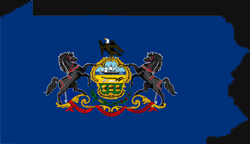
Native Americans lived the area which is now Harrisburg until about 1785. Some of the tribes were the Shawnee, Conoy, Tuscarora, Delaware, and Susquehannock.
Harrisburg is the county seat of Dauphin County and the capital of Pennsylvania. It is in the southernmost part of the state and it became the state capital in 1812.
It was settled around 1719 by John Harris from Yorkshire, England and was the origin of a trading post and ferry. He arrived in Philadelphia as one of the first emigrants to accompany William Penn. Harris was responsible for the first ferry across the Susquehanna, which in time became so popular that place was no longer called by its Indian name of Peixtan, but Harris' Ferry. It was renamed Harrisburg when it was laid out in 1785.
He moved with his wife Esther from Chester County to Lancaster County. They then soon built a log cabin on the banks of the Susquehanna, near what is now Paxton and Front streets.
He nurtured trade with the Indians in fur and skins and built many trading posts. Harris also began farming and introduced the first plow to the vicinity.
John Harris, Jr. was born about 1727. Harris, Jr. and became the founder of Harrisburg and the leader in the movement to establish Dauphin County.
This city was the place where the first national Whig Party Convention was held. It was also noted for the opening of the Pennsylvania Canal in 1834, and the arrival of the railroad in 1836.
The county it resided in was named "Dauphin," to honor of the eldest son of the King of France, who had helped the American colonies during the American Revolution.
The first court house was a small log cabin on South Front Street, which was owned by John Harris and was funded from the proceeds of the ferry. The first real courthouse was a two-story red brick building by the side of the old Lancaster Road.
Under the Act of February 21, 1810, it became the temporary Capitol of Pennsylvania in the fall of 1812, when state government was moved from Lancaster to Harrisburg.
